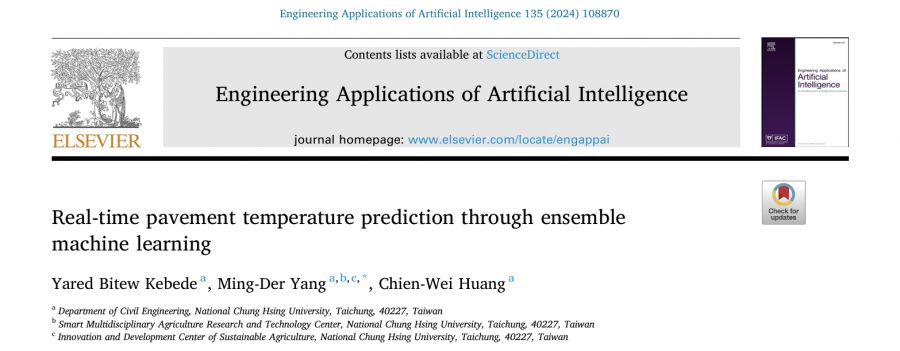科技農業:多元遙測影像AI辨識於農作溫室氣體排放評估【土木工程學系/楊明德特聘教授】
| 論文篇名 | 英文:Real-time pavement temperature prediction through ensemble machine learning 中文:透過整合機器學習即時預測路面溫度 |
| 期刊名稱 | Engineering Applications of Artificial Intelligence |
| 發表年份,卷數,起迄頁數 | 2024,135, 108870. |
| 作者 | Yared Bitew Kebede, Ming-Der Yang(楊明德)*, Chien-Wei Huang |
| DOI | 10.1016/j.engappai.2024.108870 |
| 中文摘要 | 由於其黏彈性行為,路面溫度對於評估瀝青路面的性能和結構完整性至關重要。目前,瀝青溫度預測包括分析法、數值法和統計法,依賴現場調查,耗費大量的人力和時間,妨礙了常規實踐。機器學習 (ML) 透過考慮各種動態環境因素,為可靠、準確的即時預測提供了一個有前景的解決方案。本研究採用四種整合式機器學習演算法:極限梯度提升 (XGB)、輕梯度提昇機 (LGBM)、隨機森林 (RF) 和自適應提升 (AdaBoost) 來預測不同深度的路面溫度。 XGB 始終優於其他整合模型,擁有最高的平均 R2 值 (97.92%),並且比 LGBM、RF 和 AdaBoost 更低的 MAE 和 RMSE。 XGB 的表現也顯著優於其他常用模型(線性迴歸、SVR、ANN、LSTM 和 GRU),MAE、MSE、分別為 RMSE 和 R2。採用 Shapley 加性解釋 (SHAP) 來解釋潛在的影響因素及其交互作用,並揭示大氣溫度是影響最大的特徵,在顯著特徵中貢獻率超過 40.58%。 此外,透過結合主成分分析來增強 XGB 的預測效能,以減少計算消耗,MAE、MSE、MAPE 和 RMSE 平均降低 8.98%、16.59%、9.01% 和 7.89%。具有 PCA 的 XGB 成為預測不同深度路面溫度的最有效和高效的模型,有助於及時做出預防性維護和修復決策,並防止未來災難性故障。 |
| 英文摘要 | Pavement temperature is crucial for assessing asphalt pavement's performance and structural integrity due to its viscoelastic behavior. Currently, asphalt temperature prediction includes analytical, numerical, and statistical methods and relies on field investigation with intensive labor and time to hinder routine practice. Machine learning (ML) offers a promising solution for reliable and accurate real-time predictions by considering various dynamic environmental factors. This research employs four ensemble ML algorithms: eXtreme Gradient Boosting (XGB), Light Gradient Boosting Machine (LGBM), Random Forest (RF), and Adaptive Boosting (AdaBoost) to predict pavement temperature at different depths. XGB consistently outperformed other ensemble models, boasting the highest average R2 value (97.92%) and lower MAE and RMSE than LGBM, RF, and AdaBoost. XGB also significantly outperformed other commonly used models (linear regression, SVR, ANN, LSTM, and GRU) with an average reduction in errors of 35.29%, 63.75%, 42.75%, and an increase in R2 by 4.39% for MAE, MSE, RMSE, and R2, respectively. The Shapley additive explanation (SHAP) was applied to interpret the underlying influencing factors and their interactions, and revealed atmospheric temperature as the most impactful feature, contributing over 40.58% among the significant features. Furthermore, the predictive performance of XGB was enhanced by incorporating Principal Component Analysis to reduce computational consumption with average reductions of 8.98%, 16.59%, 9.01%, and 7.89% in MAE, MSE, MAPE, and RMSE. XGB with PCA emerges as the most effective and efficient model for predicting pavement temperatures at various depths to facilitate timely decision-making for preventive maintenance and rehabilitation and prevent future catastrophic failures. |
| 發表成果與本中心研究主題相關性 | 目前發展的AI 模式以道路鋪面為溫度預測對象,可以應用在農地土壤分層溫度之預測。 |







